| Title | Article Description |
|---|---|
| REBUILDING AFTER DISASTERS USING AN INCREMENTAL CORE HOUSING APPROACH | |
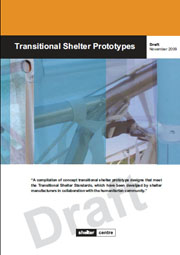 |
TRANSITIONAL SHELTER PROTOTYPES. Shelter Centre. Draft November 2009. A compilation of concept transitional shelter prototype designs that meet the Transitional Shelter Standards, which have been developed by shelter manufacturers in collaboration with the humanitarian community. (Read More) |
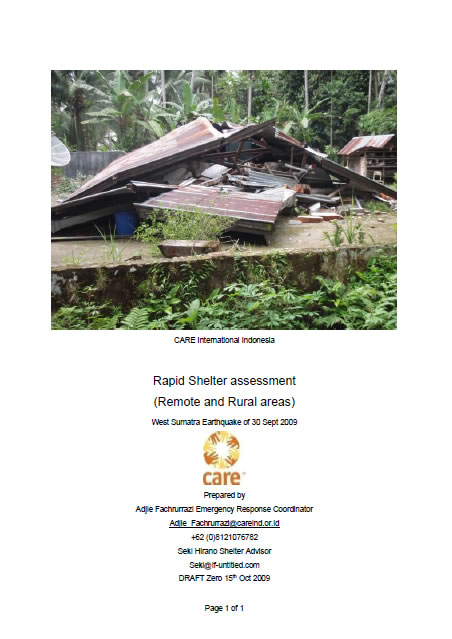 |
RAPID SHELTER ASSESSMENT (Remote and Rural Areas). West Sumatra Earthquake, 30 September 2009. CARE International Indonesia: Prepared by Ajjie Fachrurrazi Emergency Response Coordination. 15 October 2009. (Read More) |
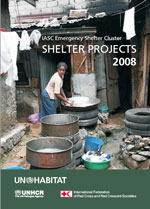 SHELTER PROJECTS 2008 - IASC Emergency Shelter Cluster. UN Habitat, UNHCR, and International Federation of Red Cross and Red Crescent Societies. SHELTER PROJECTS 2008 - IASC Emergency Shelter Cluster. UN Habitat, UNHCR, and International Federation of Red Cross and Red Crescent Societies. 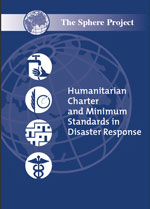 HUMANITARIAN CHARTER AND MINIMUM STANDARDS IN DISASTER RESPONSE. The Sphere Project. Geneva, Switzerland. 2004. HUMANITARIAN CHARTER AND MINIMUM STANDARDS IN DISASTER RESPONSE. The Sphere Project. Geneva, Switzerland. 2004.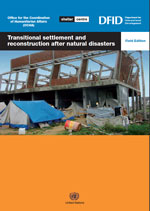 TRANSITIONAL SETTLEMENT AND RECONSTRUCTION AFTER NATURAL DISASTERS. Field Edition. United Nations: Office for the Coordination of Humanitarian Affairs (OCHA); Shelter Center; DFID. 2008. (contact us) TRANSITIONAL SETTLEMENT AND RECONSTRUCTION AFTER NATURAL DISASTERS. Field Edition. United Nations: Office for the Coordination of Humanitarian Affairs (OCHA); Shelter Center; DFID. 2008. (contact us) |
|
| EXPERIENCES FROM NICARAGUA AND GUATEMALA EARTHQUAKE RECOVERY - George Gattoni January 2010 |
Core houses and the incremental process may be appropriate for rebuilding In Haiti -- depending how it is
done. Examples In the early and mid 1970s, construction of core houses was financed by the World Bank (and
others) in the aftermath of Nicaragua's and Guatemala's earthquakes. Among the lessons in both cases were... (Read More) |
| Guatemala: Earthquake Reconstruction Project Technical Annex - World Bank |
The Government of Guatemala has requested Bank assistance in financing a reconstruction project following a massive earthquake on February 4, 1976 which severely damaged the nation causing upwards of 23,000 dead, nearly 77,000 injured and one-sixth of the country's 5.6 million population rendered homeless. In its wake the earthquake also devastated about 40% of the health facilities, 25% of the schools, and 40% of community and social facilities. Because the quake inflicted a disproportionately heavy blow to areas housing the urban poor -- where the preponderance of homes and facilities were constructed of relatively fragile materials -- disparity in wealth and income, which was extreme even before the disaster, has become more pronounced. As a consequence, social tensions are becoming increasingly pressing. These have been manifested especially through invasions by about 28,000 families of private and publicly owned land. Such a large-scale phenomenon is without precedent in Guatemalan society. (Read More) |
| Emergency Short Term Shelters in Pakistan | On the 8th of October 2005, an earthquake destroyed 600,000 houses in 4,000 villages of Pakistan Administered Kashmir and North West Frontier Province (NWFP). As an emergency response, World Wide Fund for Nature – Pakistan In collaboration with the Emergency Architects, UN-HABITAT built culturally and environmentally friendly short term shelters in Machiara, Kashmir and Siran, Palas, Pattan Valleys in NWFP. The project was funded by the UNDP. (Read More) |
| Support to Shelter Recovery in Earthquake Affected Villages in Pakistan - UN Habitat |
The victims of the Pakistani earthquake of October 2005 have been affected in a wide variety of ways including; lost lives, damaged or destroyed homes, affected livelihoods, disruption of services (health, school), and widespread displacement. (Read More) |
| Earthquake resistant housing - Practical Action |
Following a devastating earthquake in the Alto Mayo region of Peru in 1990 Practical Action became involved in a major reconstruction project to build earthquake resistant housing using 'improved quincha' – a timber and lattice frame design with an earth infill – based on traditional technologies. (Read More) |
| Monitoring Visit to BRAC Core Housing Project, Bangladesh Kenny Rae, Oxfam America and Oxfam Novib, December 12-19, 2009. |
 Oxfam America and Oxfam Novib supported BRAC in constructing 400 core houses in Patuakhali and Barguna districts in South Western Bangladesh as a response to the severe damage caused by Cyclone Sidr in November 2007. Villages were selected for shelter reconstruction work based on the scale of the cyclone damage and the relative lack of other agencies rebuilding houses. One of the key strategies of the project was to provide a strong core house which could be extended or modified by owners according to their particular household needs. (Read More) Oxfam America and Oxfam Novib supported BRAC in constructing 400 core houses in Patuakhali and Barguna districts in South Western Bangladesh as a response to the severe damage caused by Cyclone Sidr in November 2007. Villages were selected for shelter reconstruction work based on the scale of the cyclone damage and the relative lack of other agencies rebuilding houses. One of the key strategies of the project was to provide a strong core house which could be extended or modified by owners according to their particular household needs. (Read More) |

